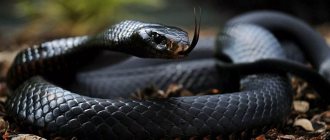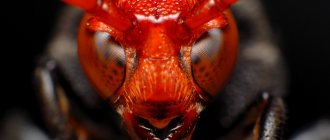The sailors of the Middle Ages lowered their voices when talking about the wonders of the ocean in port taverns. Listeners froze when the monstrous kraken became the hero of these stories, mercilessly sinking pirate ships. Let's find out what the largest squid in the world actually looks like, look at the photos and figure out whether this giant can drag a sailboat to the bottom.
How do you prefer to cook shrimp?
- Fry in a pan 51%, 1488 votes
1488 votes 51%1488 votes - 51% of all votes
- Boil 40%, 1159 votes
1159 votes 40%
1159 votes - 40% of all votes
- Cook on the grill 8%, 234 votes
234 votes 8%
234 votes - 8% of all votes
- Bake 2%, 46 votes
46 votes 2%
46 votes - 2% of all votes
Total votes: 2927
19.05.2020
- Fry in a pan 51%, 1488 votes
1488 votes 51%1488 votes - 51% of all votes
- Boil 40%, 1159 votes
1159 votes 40%
1159 votes - 40% of all votes
- Cook on the grill 8%, 234 votes
234 votes 8%
234 votes - 8% of all votes
- Bake 2%, 46 votes
46 votes 2%
46 votes - 2% of all votes
Total votes: 2927
19.05.2020
×
You or from your IP have already voted.
Origin of the species and description
Photo: Giant squid
Its descriptions have been known since antiquity, and the very first belongs to Aristotle. As for the modern scientific description, it was made by J. Steenstrup in 1857. The genus received the Latin name Architeuthis. The evolution of the class of cephalopods, in which the giant squid belongs, can be traced back to the Cambrian period, 520-540 million years ago. It was then that the first found representative of this class appeared - Nectocaris. It had two tentacles and was very small - only a few centimeters.
Video: Giant squid
However, the fact that this animal is a cephalopod, despite its external similarity, is not recognized by all scientists. Representatives of the subclass of nautiloids that arose somewhat later definitely belonged to them. Although for the most part it is extinct, some species still inhabit the Earth. An important milestone in the evolution of the class was the appearance of higher cephalopods - their shell was gradually reduced and turned into an internal one. This happened towards the end of the Carboniferous period, about 300 million years ago. Thus, the first animals appeared, similar in structure to modern squids.
They existed for many millions of years, but their evolution was very slow, and a new explosion occurred only in the Mesozoic. Then a restructuring of the entire marine ecosystem took place, including cephalopods. The biodiversity of ray-finned fish and some other sea creatures has increased significantly. As a result of this change, barefoot animals also had to adapt, otherwise they would have lost the evolutionary race. Then the ancestors of many modern representatives of the subclass of bibranchs, such as cuttlefish, octopuses and squids, appeared.
Human consumption
Many types of squid are edible. The carcasses and tentacles of mollusks are used as food. The skin is cleaned before cooking. Carcasses and tentacles are boiled, canned, fried, smoked, dried and cured. Cephalopods are used as an independent snack or as the main ingredient for preparing salads. Fried clams are a great appetizer to go with beer.
Find out more about the benefits of squid.
Appearance and features
Photo: What a giant squid looks like
The name reflects the most notable feature of the giant squid - it grows very large. Its length can be 8 meters if you count the tentacles. Previously, there was information about much larger specimens, but it was not possible to confirm them for certain. If you count without the hunting tentacles, this cephalopod reaches 5 m, and has a truly impressive and even terrifying appearance. Moreover, its weight is not so great: 130-180 kg for males, 240-290 kg for females. If in length it holds the lead among cephalopods, then in weight it is inferior to the colossal squid.
It has a mantle, as well as two trap tentacles and eight regular tentacles. The hunting tentacles are extremely long, with which it grabs prey. The tentacles have suckers, and in the middle of them the squid has a bird-like beak. To move, the squid draws water into its mantle from one side and pushes it out from the other - that is, it uses jet propulsion. So he can swim quite quickly, and to adjust direction he has fins on his mantle.
But in order to develop high speed, he needs to spend a lot of energy, and therefore he cannot do this for long. But it spends almost nothing on simple swimming: it has zero buoyancy due to ammonium chloride in its tissues. Since it is lighter than water, it can float freely in it and does not need a swim bladder. But because of this substance, its meat is unpalatable to people - however, for the giant squid itself this is only a plus.
The animal also has a complex brain and nervous system. In general, their study in recent years has become one of the important areas of research for biologists. How the brain of Architeuthis evolved is of great interest, since its organization is in many ways superior to that of humans. As a result, squids, for example, have excellent memory. The eyes of this animal are very large, they are able to detect even a very weak light source - and many inhabitants of the depths fluoresce. At the same time, they do not distinguish colors, but their eyes are able to separate shades of gray much better than human eyes - in the depths of the sea this is much more useful.
Fish or not
The name of this marine animal was established in Russia at the beginning of the 19th century after the publication of the book “Natural History of Invertebrate Animals” by the French biologist J.B. Lamarck. In turn, the author borrowed the word “calemar” from the Latin “calamarius theca”, which means “reed writing case”. The mollusk was given this name because of its ability to secrete ink, and also because its shell is shaped like a feather.
In appearance, the squid resembles a fish very vaguely. Its body, which has a streamlined cylindrical shape, is narrowed towards the end and equipped with two wide lateral fins, which allows the animal to move forward with its “tail” at high speed. The body of the mollusk is surrounded on all sides by a mantle, the shape and size of which may vary depending on its type.
On average, the body length, depending on the type of mollusk, varies from 25 to 50 cm. However, both smaller and larger species of squid are found in nature. The smallest, which belongs to the plankton group, has a length of 0.7 cm, and the largest, the Giant, belonging to the Architeuthis family, together with tentacles, is approximately 16.5 m. Cephalopods can have different colors: light gray, yellow or red -brown. Deep-sea species are mostly clear or dark red.
Do you like to cook squid?
- Yes 92%, 2455 votes
2455 votes 92%2455 votes - 92% of all votes
- No 8%, 208 votes
208 votes 8%
208 votes - 8% of all votes
Total votes: 2663
14.05.2020
- Yes 92%, 2455 votes
2455 votes 92%2455 votes - 92% of all votes
- No 8%, 208 votes
208 votes 8%
208 votes - 8% of all votes
Total votes: 2663
14.05.2020
×
You or from your IP have already voted.
Every mollusk has a shell. Teuthida is no exception. A cartilaginous arrow runs along the entire body, performing the function of the spine. It is called a “gladius” and is a vestige of an internal shell.
The head of a mollusk is not a continuation of the body, like that of fish, but has a clear line of separation from it, that is, the neck. On the sides of the neck are the respiratory organs, which are longitudinal folds separated by ridges.
Large round eyes located on the sides of the head, which are not inferior in level of development to many marine vertebrates, help the squid navigate in the surrounding space. The structure of the eye is similar to that of a human eye. The interesting thing is that each eye can track a different object.
Of the 10 tentacles located on the head around the mouth opening, 8 are the so-called arms, which are small in size and conical in shape. The remaining two tentacles are long, widening towards the end. The tentacles are equipped with suction cups and hooks, with the help of which the squid captures and holds prey.
At the base of the tentacles there is a mouth opening with two powerful jaws, which in appearance resemble the beak of a parrot. It is so powerful that it can pierce the skull of large fish. In the animal’s mouth there is a radula, which is a kind of grater with which the mollusk grinds living food and scrapes algae from stones.
A characteristic feature of squids is the presence of 3 hearts, which explains their excellent regenerative abilities.
Cephalopods have photophores - bluish spots on the body that can emit light. The source of light is bacteria that live in the squid’s body and feed on its ink. When a mollusk wants to “turn on the light,” it fills the photophores with a dark substance. The size of photophores in large squids can be about 7 cm in diameter.
To the question: “Why does a squid need photophores, scientists have not found the correct answer.” Some say that the bluish light attracts groups of small fish on which the mollusk feeds, while others say that it scares away larger sea animals that it risks becoming prey to.
Interesting! On the body of the mollusk there are photophores that can change the direction of the rays.
Squid is a commercial shellfish that is used in the food, pharmacological and cosmetic industries. In the wild, these marine animals become food for larger fish, toothed whales and seabirds.
These mollusks are harvested mainly in the southern seas of Asian countries - Vietnam, China, Japan, as well as in the Sea of Okhotsk. They are caught on the shelf of Patagonia and off the coast of the Falkland Islands, near Peru.
These mollusks are also found in the Atlantic Ocean. There they are caught along the entire coast of the African continent and further to the North Sea. The Mediterranean is rich in shellfish, and they are also found in the Adriatic. It is quite difficult to track the habitats of squids because they often migrate in search of food. The tentacles serve as hands.
Where does the giant squid live?
Photo: Giant squid in the ocean
They live in all oceans. They love moderate temperature water, so they usually live in subtropics or temperate latitudes. In too warm waters, as in too cold waters, they can be found much less often - and yet they also swim there. So, they were met in the cold northern seas off the coast of Scandinavia and even near Spitsbergen. In the Pacific Ocean you can encounter them from the very shores of Alaska to the southern reaches of Oceania. Giant squids are found in various parts of the planet, but most often off the coast:
- Japan;
- New Zealand;
- SOUTH AFRICA;
- Newfoundland;
- British Isles.
This is largely due to active fishing in these areas, or to currents that carry animals to the coasts. They can swim both at shallow depths - just a few meters - and a kilometer from the surface. Typically, young squids live at shallower depths - 20-100 m, while adults are more often found deeper. But there is no clear division: even at a depth of 400-600 m, young architeuthis can be found.
Likewise, old individuals sometimes float to the very surface. But usually they live at a depth of several hundred meters, and are maximally capable of diving to 1500-2000 m, into the real kingdom of darkness - there they also feel quite comfortable. Even that weak, elusive light to the human eye that penetrates there is enough for them.
Interesting fact: This cephalopod has three hearts and blue blood.
Now you know where the giant squid is found. Let's see what he eats.
Dimensions of Architeuthis
As mentioned above , squid is the largest mollusk among the inhabitants of the seas and oceans, which still exists in our time. And once upon a time, many hundreds of years ago, there were mollusks that were much larger in size, but they did not survive to our time.
People who saw such a monster often exaggerated its size, often out of fear. Today there is a lot of information that there are individuals that have a length of up to twenty meters or more, but there is no evidence of this.
Scientists have already studied more than one hundred and thirty species of squid. The results that were obtained and the existing photographs make it possible to conclude that Architeuthis is the largest squid of all existing ones.
According to recent studies, it can be seen that the longest length of a squid’s mantle is 22.25 meters, the largest weight is 275 kilograms.
What does the giant squid eat?
Photo: Giant squid Architeuthis
Relatively little is known about the diet of architeuthis: it is difficult to observe them in the wild, and therefore conclusions can only be drawn from the contents of their stomachs and various indirect signs.
They feed on:
- schooling pelagic fish;
- deep sea fish;
- octopuses;
- cuttlefish;
- stingrays;
- other squids.
He ignores fish and other living creatures that are too small, but fish over 10 cm in size can interest him. Since they were caught only one at a time, it is assumed that they live and hunt alone. In addition, they are most often caught off the coast of New Zealand - they are caught by trawls catching grenadier. At the same time, Architeuthis do not eat this fish itself - from this we can conclude that their diets are similar.
The giant squid cannot hunt actively: it has almost no muscles for fast movement. Therefore, he tries to lie in wait for the victim and attack him unexpectedly. To do this, the cephalopod lurks in the darkness at great depths and, when another squid or fish swims past, it extends grasping tentacles - only they have powerful muscles.
With its tentacles it firmly grasps the prey, then brings it to its sharp beak and with its help tears it into pieces, and then grinds it into pulp with its rough tongue - this makes further digestion much easier.
Interesting fact: If a squid loses a tentacle due to a predator attack, it can grow it back.
Giants attack people
It is worth noting that the captain of a Norwegian fishing tanker, Arne Grönningseter, recently told the public an amazing story about a huge kraken. According to him, giants pose an incredible danger to people who devote their lives to fishing, or simply those who like to be at sea. The fact is that his ship Brunswick was attacked several times by the aforementioned monster. The captain spoke about the tactics that the mollusk chooses to attack: it first floats to the surface of the water from the abyss, then accompanies the ship for a short time, as if waiting for a certain moment, and then with lightning speed it emerges from the water and pounces on the ship. Only due to the fact that the tentacles of the cephalopod monster could not catch on the surface of the deck and the hull of the ship, the crew managed to escape and remain unharmed in the unequal battle.
Features of character and lifestyle
Photo: Antarctic giant squid
Thanks to their neutral buoyancy, giant squids save a lot of energy - because it does not need to be spent on maintaining their position in the water. At the same time, due to the abundance of ammonium chloride, their tissues are flabby, they themselves are sluggish and move little.
These are solitary creatures that spend most of their time alone - they simply drift, without making any effort to do so, or they hang in the water and wait for prey to swim up to them. As a result, their character is calm, even lethargic: it is unlikely that any of the stories about attacks on ships are actually true.
Sometimes giant squids wash up on the shore, where they die. This happens due to a sharp drop in water temperature - their body tolerates this extremely poorly. Their strength simply leaves them, they generally lose the ability to move and are caught by the current, which sooner or later carries them to the shore, where they die.
In general, moderately cold water is not dangerous for them, they even love it, which is why they can swim into the northern seas. It is the sharp temperature change that has a detrimental effect on them. Therefore, squids usually wash ashore near places where warm and cold currents converge. The more architeuthis that came into the hands of researchers, the clearer it became: they live as long as the most common squid, they just grow very quickly, especially females.
Already in the first year of life they can grow from a very small larva to several meters in length. By the end of the second year they reach the size of an adult, and at about the same time or a little later they reach sexual maturity. After spawning they die - and it is rare that architeuthis avoids it for years and therefore lives.
Great luck for scientists
A significant period of time after Robson’s study of the tentacles of the sea monster, scientists discovered 4 eggs in the far Atlantic, presumably left by mollusks. Having studied their composition and origin, they came to the conclusion that the eggs actually belonged to a female squid of a rare species, mesonychoteuthis. Scientific data appeared in 1970, that is, almost 50 years after Robson’s first experiment. The characteristics and features of the surviving masonry were carefully studied by experienced specialists of the time. And 9 years after the research work, it was possible to catch an adult specimen of mesonychoteuthis. Her mantle measured 117 cm in length, and she was the largest female squid in the world.
Social structure and reproduction
Photo: Eyes of a giant squid
Little is known about how the giant squid reproduces. The male has a penis extending from the mantle through which sperm is ejected, but due to the fact that these cephalopods do not have a hectotile (the tentacle that carries sperm), the mechanism of its delivery remains unknown. Fertilized females produce a lot of eggs – the number is in the tens of millions. Each one is very small, about a millimeter. It seems incredible that it could grow into such a large animal.
Due to the large number of eggs, their total weight can be 10-15 kg, but how exactly the female lays them is still unknown, how and what happens to them immediately after this. There are two main options: first, some scientists believe that they are enclosed in a special masonry that protects them from external conditions. In it, the eggs float near the bottom until the time when the fry need to hatch, which after that spread out - it is not known exactly after what time this happens. Scientists have not yet come across such schools of larvae, and in general, finds of giant squid fry are extremely rare.
Because, and also due to the fact that adult squids are found all over the world, while genetically they are all closely related to each other, other scientists defend the point of view that the eggs are not kept in the same clutch, but are simply given up to the water, and currents carry them over long distances even before the fry are born.
In this case, the vast majority of the eggs should die due to the vicissitudes of fate and sea currents. From the few that have survived, larvae emerge - they are also very small and defenseless, so that in the first months of life, even small fish can threaten the future huge predator. And after spawning, their parents are exhausted and simply die, after which they are most often washed ashore. For a reason that has not yet been established, these are almost always females, but it is believed that males also die, they simply drown and settle to the bottom.
Water too warm
As you can see, it’s not for nothing that Humboldt squid are considered more dangerous than white sharks. The force of compression of their jaws is several times greater than that of a lion. There are known cases when these mollusks bit through a metal cable. But all this does not prevent them from being objects of fishing! For many years, Mexican fishermen lived by catching Humboldt squid. But now bad times have come for them, as well as for the cephalopods themselves, which are shrinking before our eyes. Previously, fishermen used bait weighing 500 g for them, but now the squids themselves weigh less: about 30 individuals fit in one bucket, but before it was too small for even one. Sperm whales, for which Humboldt squid were the mainstay of their diet, are also suffering: with a decrease in their numbers and size, the giants are leaving the Gulf of Mexico en masse. What happened to the mollusks, why did they decrease so much in size? Stanford University employee Tim Frawley tried to answer this question. During the study, he found that the water in the Gulf of Mexico was always balanced between the warm water phases of El Niño and the cool water phases of La Niña. Warm water is unfavorable for huge clams. But when it gave way to cold weather, the population managed to recover. However, recently the warm water phase has become longer and longer. To survive in these conditions, Humboldt squids began to reproduce not at 1.5 years, but at an earlier age - 5-6 months. They were allegedly afraid that they would soon run out of food, so they urgently produced offspring. Or migrated. In 2004, oceanographers working off the coast of Alaska noticed about a hundred large squid in the water. When they managed to pull one of them to the surface, it became clear that this was a Humboldt squid. And this despite the fact that previously the habitat of these mollusks was considered to be the waters of the Pacific Ocean, more than 3000 km away from Alaska! Individual individuals have swum here before. But for them to migrate en masse? This have not happened before. Since then, regular encounters with Humboldt squid have begun to occur in the Gulf of Alaska. And it is possible that unfavorable conditions and a reduction in the number of predatory commercial fish will force these cephalopods to expand their habitat even further. So, you see, modern sailors and fishermen will begin to repeat after their medieval predecessors stories about giant krakens dragging ships to the bottom of the sea...
Fishermen's storm
Of course, there is no need to fear that Humboldt squid will someday threaten humanity as a whole. But for fishermen they are already dangerous. Including because they destroy commercial fish, such as hake, anchovies and many others.
Natural enemies of giant squids
Photo: What a giant squid looks like
Only the sperm whale can successfully attack an adult Architeuthis. This is his most terrible enemy, and if previously it was widely believed that real deep-sea battles were being played out between these two predators, in which either one or the other could win, it is now clear that this is not so.
Not only is the sperm whale larger, but the giant squid also has very few muscles, and can only fully wield two tentacles. This is not enough against a sperm whale, and there is practically no chance of victory if it has already grown to the size of an adult. That’s why it is sperm whales that always attack.
The squids cannot even escape from them - after all, the sperm whale is much faster, and all that remains is to engage in battle with very little chance of winning, and even less of surviving. Sometimes these battles end in the death of both sides: once a Soviet ship observed this, in which a squid, having been swallowed, already dying, pulled tentacles straight from the sperm whale’s stomach and strangled it.
Another predator capable of killing Architeuthis is the elephant seal. But otherwise, adults have nothing to fear, but juveniles are a completely different matter. Very small ones can be eaten by any predatory fish, and even grown-up ones can be killed by deep-sea sharks, tuna, swordfish and other large sea predators.
The terrifying Mesonychoteuthis
It is now known for certain that Architeuthis is far from the only species of inhabitants of the depths that frighten humanity with its size. Since time immemorial, there has been another representative of giant monsters of the cephalopod species on earth - mesonychoteuthis. This giant squid monster is considered one of the largest in modern times. It can be called a close relative of Architeuthis, only it is much more majestic. Mesonychoteuthis is the only representative of its genus, because, unlike Architeuthis, its weight is somewhat larger: the mantle of adult individuals alone reaches a mind-boggling size - its length is equal to four meters. By the way, another name for a giant is colossal.











